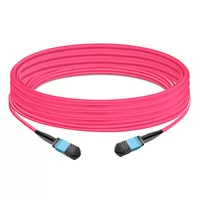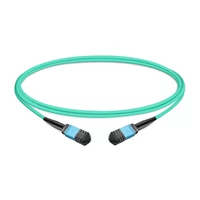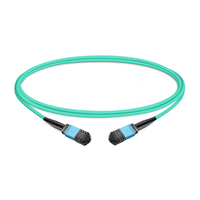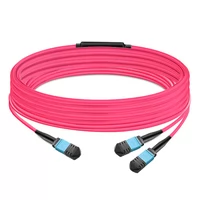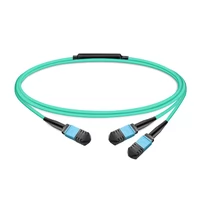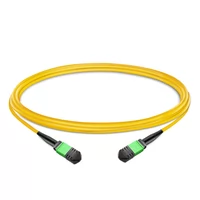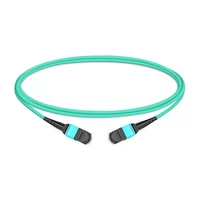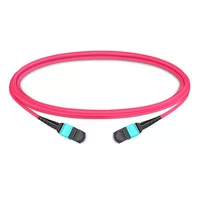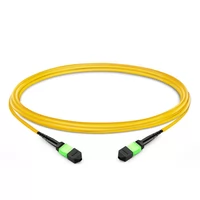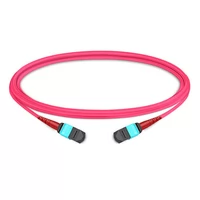To meet the growing demands of data traffic, it is necessary for data centers to be dynamic and multi-faceted. This means that efficient high-speed connectivity should be prioritized. Multi-fiber Push-On (MTP) connectors play a key role in optimizing data center performance. In this article, we will discuss MTP fiber connectors‘ technological advancements as well as their practical applications, such as expanding network scalability, improving rates of data transmission, and reducing latency periods, among others. We hope that through different use cases and benefits, readers will get insights into various ways in which MTP fiber optic cables can unlock new potentials in modern infrastructure for information storage facilities.
Table of Contents
ToggleWhat Makes MTP® Connector Superior to Traditional Fiber Optic Connectors?

The Evolution from MPO to MTP®: Technological Advancements
MPO connectors laid the groundwork for MTP® connectors which improved upon them in several significant ways to become better suited for today’s data centres. Like MPOs, these are also multi-fiber connections but come with extra features like increased mechanical stability or strength, higher optical clarity, and superior alignment precision, among other improvements brought about by having customizable housings as well as demountable housings that allow easy access during cleaning or repolishing steps. What’s more? They have lower insertion loss and reduced crosstalk levels coupled with enhanced thermal stability over their counterparts, i.e., lower insertion loss(reduced crosstalk levels)(enhanced thermal stability) so that more speed could be achieved when transmitting information between devices located at different points within a network structure thus making them ideal components for future-proofing pathways within Data Centers of tomorrow where speeds will always be going up.
Understanding the MTP® Connector: Key Features and Benefits
The MPO connector, a high-performance variation of the MTP® connector, is designed to be used in modern data centers. Here are a few key points about it:
- Higher Density: This type of connectors allows up to 72 fibers to be connected at once, which means that they can be installed densely and save space within data centers.
- Low Insertion Loss: Optical clarity is improved with precise alignment so that signal loss during transmission does not exceed its minimum level required for this purpose. It also helps networks work faster by making them more reliable.
- Better Mechanical Durability: These connectors are made from stronger materials and better built than others like them, which makes them last longer even when used under severe conditions.
- Scalability: They can be easily scaled up or down as needed in any part of the network without causing too many changes elsewhere within the infrastructure, such as data centers.
- Customizable: Users may adjust housings according to their specific requirements since different types and lengths of cables are available too.
- Ease of Installation and Maintenance: This design simplifies the installation process while allowing quick cleaning followed by easy re-polishing so that downtime becomes less frequent, thus saving time spent on maintenance activities.
- Reduced Return Losses: By having better geometry at one end face combined with meeting higher standards for precision at another end face significantly leads into realizing more loss on return path thereby showing higher performance together with integrity signals.
All these features put together justify why MTP® connectors outperform other options when it comes to enhancing speed in information transmission; creating strong flexible networks; improving overall efficiency of data centers.
Comparing MTP and Traditional Fiber Connectors: A Side-by-Side Look
Fiber Density
A conventional connector can typically handle only one or two fibers. In contrast, MTP® connectors can support up to 72 fibers in a single connector. Space is saved by these high-density connectors and cable management becomes easier and more efficient in areas where space is limited.
Insertion Loss
The reason why the loss of insertion is low when it comes to MTP® connectors is that they have advanced optical clarity and are precisely aligned thus ensuring minimum signal degradation which could occur as a result of traditional connectors having higher insertion losses than required hence affecting network performance as well reliability.
Mechanical Durability
MTP® connectors offer superior mechanical durability because of their strong build quality and materials used during manufacturing process unlike other fiber optic connections which though reliable do not have similar resilience levels under harsh environmental conditions such as those encountered outdoors or industrial sites with extreme temperatures range even above freezing point.
Scalability
MPTP connectors are highly scalable, making them suitable for networks that need frequent expansion. However, this cannot be compared to traditional fiber optics cables, where reconfiguring everything else along the line becomes necessary due to space limitation caused by an increase in the number of connections made over time at different locations within building premises themselves alone without any additional interconnecting points between buildings or floors thereof.
Customization
When it comes to customization options, MTP® connectors take the lead with adjustable housings for different cable types and lengths thereby allowing users come up configurations tailored meet specific needs unlike what happens when working on ordinary connector setups which may require some major alterations before achieving targeted results.
Ease of Installation and Maintenance
Installation procedures are straightforward since they were designed with simplicity in mind, while cleaning can easily be done through efficient re-polishing thus saving much-needed time during the setup phase coupled with long-term care-taking activities involved thereafter, especially considering that typical installations involve complex steps compared to regular ones requiring ongoing attention as well efforts being put place throughout their lifetimes so far.
Return Loss
MTP connectors have high return loss like other types of fiber optics which means better performance in terms signal quality hence reliable connectivity. However, traditional fiber connectors tend to exhibit lower return losses thereby compromising on signal integrity.
In summary, MPTP connectors are superior to old-fashioned ones because they have more fibers per connector and lower signal degradation during transmission due to advanced optical clarity with precise alignment, among others, as highlighted above. They can also withstand harsh environmental conditions where conventional fiber optic connections fail, thus making them best for scalable data center networks that require frequent expansion while saving time on both the setup phase and ongoing caretaking activities over long-term usage periods.
Exploring the Role of MTP Fiber Cables in High-Density Networks

Why High-Density Matters: The Importance in Data Centers
The exponential increase in data traffic, together with the demand for high bandwidth, requires modern data centers to use high-density fiber optic solutions like MTP® connectors. They allow many connections to be hosted within a small space, thus ensuring that space is utilized to its fullest capacity. This is important because cost-effectiveness is achieved through reducing physical footprints due to expensive real estate at data centers. Also known as crowded cabling, these cables support faster rates of transmitting information, which is required by large-scale applications such as cloud computing, big data analytics, and content delivery networks.
Furthermore, dense connectivity makes cable management easier – a factor that reduces congestion risks and possible damage to wires, hence improving reliability levels besides simplifying maintenance activities. Moreover, it provides for future scalability, hence allowing growth without major overhauls, thus keeping pace with technology advancements and the growing need for processing power as well as storage facilities. Currently, therefore, it will not be enough just to prefer the adoption of this type of technology but rather to make sure that all centers are fitted with it since failure can lead to both performance inefficiencies and lack of adaptability.
MTP Fiber Cables and Data Transmission: Maximizing Bandwidth
MTP fiber cables are of great importance in high-density networks for maximizing bandwidth. They have several fibers accommodated in a single connector which enables them to provide higher data throughput than traditional fiber cables. MTP connectors are made to support high-speed data transmission necessary for 40G, 100G, and beyond applications. The multi-fiber design saves on cabling space, thereby enhancing the efficiency and tidiness of data center infrastructure.
Apart from this, MTP fiber cables also guarantee better performance with lower insertion loss as well as superior signal integrity which is critical in maintaining optimum speeds of transmitting information. Moreover, using MTPs simplifies scalability because it allows easy network upgrades without much reconfiguration being done elsewhere, thus making these types of wires most suitable for those centers that would want to increase their capacity but, at the same time, save on both physical space requirements and potential points of failure. For this reason alone, therefore, integration of such kind into any system is not only inevitable but also necessary if at all we were to cater adequately to increased demands brought about by cloud computing services together with other storage-intensive programs powered by high-performance computers (HPC).
The Impact of Cable Management on Network Efficiency and Scalability
Data centers must have effective cable management because it is crucial for network performance and scalability. Neatly arranged wires reduce traffic jams and other kinds of electromagnetic interference, which improves air conditioning and increases the lifespan of hardware parts. Good cable routing minimizes signal attenuation and electrical noise pollution that would otherwise slow down data transmission rates. Additionally, tidying up cables in such a way makes it easier to maintain or upgrade them when necessary, thus preventing long periods of downtime while also cutting operational expenses. Robust cable management solutions should be invested in so that higher density configurations can be supported by data centers, which will then allow them to grow their infrastructure without any bottlenecks as well as always remain efficient, considering modern network environments keep evolving rapidly.
The Fundamentals of MTP/MPO Polarity and Its Importance in Fiber Networks

Decoding MTP/MPO Polarity: What You Need to Know
The polarity of MTP/MPO pertains to the arrangement of fibers in a multi-fiber cable which is necessary for proper data transmission through fiber optic networks. There are three categories of polarity configurations: Type A, Type B, and Type C.
- Type A (Straight-Through): This configuration maintains consistency throughout the fiber link by having the same orientation from one connector to another.
- Type B (Reverse): It reverses the orientation such that the positions of fibers at one end are swapped with those at another end; this enables opposite positioning commonly used in duplex links.
- Type C (Pairwise Flip): Adjacent pairs are flipped over in this case; it is particularly applicable where parallel optics are required.
One must choose the right kind of polarity for correct alignment as well as to avoid signal loss or connectivity issues. Additionally, network reliability and ease of maintenance can be achieved through proper documentation and following industry standards like TIA/EIA-568. These arrangements simplify deployment and troubleshooting processes within high-density fiber optic networks.
Maintaining Proper Polarity: Solutions and Best Practices
Ensuring proper MTP/MPO polarity is about doing things right. Following this approach can, therefore, prevent connectivity issues before they happen while optimizing network performance. One major step in solving this problem involves using pre-terminated cables with factory-tested polarity configurations; this eliminates guesswork and reduces errors during installation. Moreover, polarity management tools like testers can be used to validate connections prior to network deployment, which will save time and money that would have been lost due to signal failure or downtime.
Another part of best practice is good record keeping, such as labeling every fiber link and connector used for identification purposes during maintenance periods or when scaling up capacity so that troubleshooting becomes easier if any problems occur later on down the line. Additionally, regular training sessions should be held where industry standards like TIA/EIA-568A are taught, among other things, so that all staff members who work in areas connected with operational activities related to networks know how to maintain a correct policy within their work scope.
Finally, cleaning connectors regularly and inspecting them periodically is necessary in order to keep the integrity of the entire system intact because dust particles may cause misalignment, thereby degrading signals. Similarly, it may be helpful to carry out optical time domain reflectometer (OTDR) testing, which could reveal some anomalies connected with polarity within certain sections of a given network. Therefore, administrators need both these approaches together with other recommendations and should ensure reliability and effectiveness when dealing with high-density fiber optic systems.
How Polarity Affects Connectivity and Performance in Fiber Systems
Connectivity and performance are directly influenced by polarity in fiber optic systems. Polarization is important because it aligns the path through which a signal is transmitted from the transmitter (Tx) to the receiver (Rx). When polarities are mismatched, signals can be lost, data transmission rates may decrease, or error rates might increase; this becomes more significant as networks become denser, where even slight misalignments can cause severe degradation of performance.
Systems with many fibers like MPOs (Multi-fiber Push On) or MTPs (Multi-fiber Termination Push On) connectors need accurate polarity management too. These types of connectors enable faster speeds and larger volumes of data to be transferred which is necessary for data centers and other large-scale networks. If these devices are not configured correctly then there will either be no link between them or it will work poorly due to mismatching.
Troubleshooting becomes much harder when polarity is wrong because extensive testing has to be done along with reconfiguring everything back again; this could lead to longer downtimes, therefore increasing operational costs as well. This risk can be reduced by using cables that were pre-tested and factory-configured. Polarity testers should also be used together with automated documentation tools if one wants their system integrity guaranteed even more.
To sum up, it’s essential for fiber optic networks’ best performance and reliability to maintain proper polarity. It promotes effective information transmission and decreases signal losses while at the same time increasing general network scalability so that maintenance becomes easier in the future.
Navigating MTP® Connector Cleaning and Maintenance for Optimal Performance

The Necessity of Cleaning MTP® Connectors: Maintaining High Performance
The vitality of cleansing MTP® connectors is the function that dirtiness performs in spoiling optical performance. Connector end faces might have dust, soil, or oil that can cause big insertion loss and return loss besides compromising signal integrity. It is important to maintain and clean MTP® connectors on a regular basis so as not to block the light path with these pollutants, thus guaranteeing dependable high-speed data transmission. Sustainable network optimization and longer connector life can be achieved by following correct cleaning techniques, such as using appropriate tools for connector cleaning and adherence to standard procedures. Failure to do this leads to more errors in transmission, greater amounts of lost information, and overall inefficiency of networks.
Proven Techniques for Effective MTP® Connector Cleaning
In order for them to remain effective, tested cleaning methods should be followed whenever dealing with MTP® Connectors. For instance, specialty cleaners such as one-click cleaners or cassette cleaners designed specifically for cleaning MTP® connectors can be used since they are among the most efficient. With these tools, it becomes possible to clean the connector end face accurately without causing any damage at all. Another technique involves wiping off stubborn contaminants using lint-free wipes together with optical-grade solvents meant for cleaning purposes only (not other types). Automated systems for cleaning may also be applied during comprehensive maintenance where repetitive results need to be achieved over many connections but need consistency while doing so. Apart from that, before conducting an inspection through fiber scopes, ensure no debris remains attached and either side of the connection has been removed completely; otherwise, stick with these standardized steps, which will minimize insertion/return losses, thus enhancing general performance levels across networks.
Preventing Contamination: Tips and Tools
To ensure ideal network performance and avoid expensive downtime, one must prevent MTP® connectors from being contaminated. Here are some tips and tools to help you with that:
- Always Keep Dust Caps On: When not using them, keep dust caps on connectors so dust or other contaminants do not settle onto their end faces.
- Use Proper Handling Techniques: To prevent oils and debris from your hands from being transferred onto fiber, handle connectors by their housing.
- Environmental Control: Use anti-static mats and air purifiers for cleaner work environments since they reduce airborne contaminant levels.
- Regular Training: Train all staff members in correct cleaning methods and how to handle these devices. Regular training promotes consistency across the board while minimizing errors caused by human intervention.
- Regular Inspection: Conduct periodic inspections early enough through fiber scope checking so as to identify contamination and take necessary measures against it.
- Utilize Cleaning Tools: Make use of dedicated cleaning tools like specially designed one-click cleaners, cassette cleaners as well as lint-free wipes containing optical grade solvents.
- Automated Cleaning Systems: Automated cleaning systems provide consistent results throughout repetitive tasks hence reducing chances of getting contaminated especially when dealing with large-scale operations.
You can effectively avert pollution, thus protecting the integrity of your network, by following these suggestions and incorporating them into your maintenance schedule.
Choosing the Right MTP Fiber Cable: Trunk Cables vs Breakout Cables

Understanding the Difference: Trunk Cables and Breakout Cables Explained
MTP fiber cables come in two varieties: the trunk cable and the breakout cable. Both these types are used for different purposes within a fiber optic network but remain different.
Trunk Cables: These cables form the main link between data centers and other network elements located within a telecommunication room or any other suitable place. They can either be single-mode or multi-mode and usually contain several fibers bundled together in one cable for long distance transmissions. Trunks are terminated on both ends with MTP connectors thus promoting simple management of cables since it enables rapid deployment as well as scalability.
Breakout Cables: Another name for breakout cables is harness cables; they connect directly from one MTP connector into many separate fiber connectors, such as LC or SC connectors. This is applicable where there is a need for individual port accessibility, i.e., patch panels, switches, or servers, among others. Breakouts work best when used over short distances within a data center or telecom room because they allow great flexibility when connecting numerous devices using fewer wires, hence reducing clutter created by multiple cords.
To put it briefly, while trunk cables may be more suited towards making high density backbone connections that cover long distances; breakout cables are good at making short reach connections requiring flexibility while doing individual port connection. Which type to choose depends on specific requirements of the network being setup vis-à-vis its physical environment during installation.
Deciding Between Trunk and Breakout Cables: What’s Best for Your Project?
When deciding on whether to use trunk cables or breakout cables for your project, take into account the following points:
- Scope of the project: Trunk cables are best utilized in large scale deployments with high density and long distance connections needed typically found in data centres or across telecoms networks. If you have a lot of infrastructure that needs to be quickly scaled up and down while still running very efficiently then trunking could work well.
- Type of Connection and Accessibility: Breakout cable would be more suitable where there is direct connection required between individual devices such as switches, servers or patch panels. Breakouts provide flexibility by allowing access to ports within short distances which makes them ideal for local environment setup.
- Distance and Density Requirements: In situations where long range transmission is key along with many fibers being deployed at once (high counts), this is where trunking shines as it reduces overall size through consolidating multiple fibers into one sheath. Conversely breakout fiber optic cables work best when used over shorter distances since they allow easy access to single mode fibers hence reducing clutter.
- Installation & Maintenance; If easy installation together with future reconfiguration matters most then go for simple trunk cables having their connections terminated using MTP connectors on higher fiber counts. On the other hand break outs offer simple individual connections which might be less complex to manage within small-scale systems or those that are highly modularized.
Evaluate these considerations against specific network requirements and deployment environments so as to choose whether you will use either trunks or breakouts during your project.
Optimizing Your Fiber Network with the Correct Cable Type
When you are optimizing your fiber network, the selection of the right cable type is crucial for efficiency and performance. Here are some considerations to help you make an informed choice:
- Designing the Network and Future Proofing: Trunk cables can be used where scalability is required in large scale installations. They have more fibers within one jacket which makes it easy to manage cables during installation and also allows for future expansion especially in data center environments.
- Connection Requirements: When there is need for direct connection with individual devices like switches or servers then breakout cables come in handy because they offer port-to-port connectivity thereby providing a flexible solution that can be used for short distance runs as well as patching scenarios.
- Distance and transmission requirements: In this case, trunk cables are recommended for long-distance transmissions since they reduce bulkiness by consolidating many strands into one, thus supporting high fiber count environments while still utilizing space effectively.
- Ease of Installation/Maintenance: For quick deployment time, trunk cables often come pre-terminated with MTP/MPO connectors, which simplifies their installation, but if managing small or modular setups where individual connections need to be made, then breakout cable is much easier to deal with.
- Cost Considerations: It’s important to evaluate total ownership cost including installation, maintenance as well any possible future upgrade so may be higher at first sight however over wider areas these could turn out cheaper over time due their manageability among others.
By examining each of these factors systematically, one can enhance their fiber optic network through identification of various operational needs as well ultimate objectives.
Overcoming Common Challenges with MTP/MPO Fiber Installations

Identifying and Resolving Alignment Issues in MTP/MPO Connections
Alignment problems in MTP/MPO connections are one of the most frequent issues faced, and they may result in poor performance and increased signal loss. Often, these are caused by bad-quality connectors, incorrect handling, or contamination. In order to effectively find and fix such problems, follow these steps:
- Check connectors: Examine each connector using a fiber microscope, checking for visible contamination, scratches, or other defects. Cleanliness is next to godliness when it comes to connector care.
- Cleaning procedures: Use suitable tools with dry or wet cleaning techniques along with specific solutions designed just for this purpose. Cleaning should be done regularly so that there is no compromise on signal integrity leading to higher insertion loss.
- Re-seating Connectors: Sometimes, all that is required for fixing misalignment problems may be as simple as re-seating them gently into their positions again while ensuring they are well aligned where necessary, thereby improving the stability of the connection at large.
- Connector alignment tools: Whenever mating two MTP/MPO connectors together during installation ensure accurate alignment through use of alignment pins or guides provided by the manufacturer. These aids help align fibers precisely thus minimizing any loss due to poor mating.
- Regular testing: Conduct Optical Time Domain Reflectometer (OTDR) tests among other diagnostics aimed at early detection and mitigation of misalignments. Frequent checks enable quick identification and correction of any problem identified, hence preventing downtime associated with such failures.
- Quality components: Buy genuine high-standard MTP/MPO parts from well-known manufacturers only because everything else will fail without proper alignment being achieved between different points within an optical link system, let alone risks posed by fake ones causing misalignments even if they seem okay physically.
So follow these steps systematically when dealing with alignments and you will greatly improve performance and reliability of your fibre optic network based on MTP/MPOs.
Installation Best Practices: Saving Time and Reducing Errors
- Pre-Installation Planning: Perform an in-depth examination of the area, as well as creating a complete installation process. This includes validating infrastructures; making sure that the necessary materials are already onsite; and determining what kind of environment will be used for installation to anticipate any problems.
- Standardized Procedures: Employ universal approaches towards all tasks involved in installing it. This can help lower mistakes made and increase efficiency by using checklists and following standards set within industries.
- Cable Management: One should also know how important it is to manage cables properly. Cable ties, labels, and routing guides are just some examples of neat ways you can organize them so they do not get tangled up or get damaged.
- Assessment and Documentation: Always evaluate quality during installations while documenting every step taken throughout the process. This way future maintenance work becomes easier because accurate records act as reference points hence reducing chances of making mistakes when troubleshooting systems.
- Utilization of Quality Tools: Make sure technicians have been provided with good tools plus testing equipment too. Precision tools minimize fibre optic network installation errors while at the same time increasing its reliability.
- Training and Certification: Invest in training programs coupled with certifications for those responsible for conducting installations. Such individuals become more competent thereby being able to perform their duties correctly thus lowering chances of rework being done.
- Environmental Controls: Keep control over surroundings during installation so that fragile parts do not come into contact with dirt or moisture due to extreme temperatures, which might affect them adversely either. Use clean working areas along protective covers throughout this period until everything has been completed successfully.
- Real-time Monitoring: Introduce monitoring systems that will keep track of progress made during installation, together with the quality levels achieved at different stages. Immediate feedback can be given by these systems, thereby helping one identify issues before they develop into bigger challenges.
- Redundancy and Backup Plans: Come up with alternative arrangements meant for dealing with failures if any were to occur. One should always have backup devices ready alongside fast response procedures in order to minimize service downtimes.
- Post-Installation Testing: Test all parts that have been fitted to ascertain whether they meet required performance standards or not. Signal integrity and alignment ought to be verified using OTDR among other diagnostic tools so as to make sure everything has been done right during installation thus saving both time & energy.
Following their implementation, these tips can help quicken the process of installing fiber optic networks, reduce mistakes made and guarantee a reliable network of high quality.
Enhancing Installation Efficiency: Tools and Techniques
To heighten the effectiveness of fiber optic installations, there are several methods and tools that can be used:
- Automatic Splicer: Automated splicing machines use fusion splicers to splice fibre optic cables together efficiently and reliably. These machines ensure precise alignment and fusing, thereby reducing splice losses, which enhances network performance overall.
- Cable Blowing Apparatus: Utilize cable blowing equipment to quickly deploy cables over long distances without causing any damage to them. This method ensures uniform installation speed while minimizing physical stress on the cable itself.
- Software for Installing Management: Deploy specialized software for planning, managing and monitoring installation projects. Such tools facilitate resource allocation, scheduling as well as progress tracking thus making operations more efficient.
- High-Precision Cleaver: Use precision fiber cleavers having low angle errors during preparation of fibre ends which enables better performance in terms of splicing and connectors leading onto stable networks with higher efficiency levels.
- Portable OTDRs/Test Equipment: Employ portable Optical Time-Domain Reflectometers (OTDRs) among other diagnostic devices during installations so that the quality tests for splices and connectors can be done immediately, allowing instant corrections where necessary.
- Fiber Optic Polishing Machine: Automatic polishing machines should be used on connector end-faces to meet industry standards hence reducing insertion loss and back reflection that may occur due to poor finishing.
- Comprehensive Tool Kits: Provide technicians with complete tool kits containing stripper, crimping tools, inspection microscopes, etc., all necessary for different types of installations tasks to be carried out effectively by them at site.
- Pre-Terminated Fiber Assemblies: Save time spent on field terminations by using pre-terminated fiber assemblies. These are already tested under controlled environment conditions making them faster and more reliable during deployments.
- Virtual Reality (VR) & Augmented Reality (AR) Training: Implement VR & AR into technician training so that they can simulate real-life scenarios while practicing their skills within a safe environment.
- Efficient Ladder Racks/Cable Management Systems: Ensure that cable organization is done properly by using well designed ladder racks and cable management systems so as to prevent damages which might occur later during maintenance works.
By incorporating these techniques with the tools themselves, efficiency will be greatly improved while at the same time minimizing risks hence leading to a very strong & dependable fiber-optic network.
Reference sources
- “Optimizing Data Center Connectivity: The Role of MTP Fiber Connectors” – Data Networking Insights
- Source: https://www.datanetworkinginsights.com/mtp-fiber-connectors-data-center-connectivity
- Summary/Annotation: Fiber optic technology has advanced greatly in recent years. This article will explore some of these advancements and how they can be applied to modern data centers. The author discusses what an MTP connector is, as well as its benefits and uses within a data center setting. They also provide information on compatibility with other infrastructure components and best practices for implementation.
- “Advancements in Fiber Optic Technology: Unleashing the Power of MTP Connectors” – Tech Innovations Journal
- Source: https://www.techinnovationsjournal.com/fiber-optic-technology-mtp-connectors
- Summary/Annotation: This PC World article focuses on the use of MTP connectors for optimizing data centers. It explains what MTP connectors are, why they are important in modern data centers, and their applications across various industries. Additionally, this source also discusses the benefits of using MTP connectors over traditional ones, scalability options available with them, as well as tips for proper installation.
- “Enhancing Data Center Performance: The Future of MTP Fiber Connectivity” – Networking Solutions Forum
- Source: https://www.networkingsolutionsforum.com/mtp-fiber-connectivity-data-center-performance
- Summary/Annotation: This article from Data Economy magazine looks at how businesses can simplify networking in their data centers by adopting MTP fiber optic connectors. It starts off by explaining what these connectors are used for before delving into their main features, such as scalability and high-speed transmission support, among others. Besides this, the piece also highlights some considerations one should make when deploying them, like selecting appropriate patch cords or cleaning tools, among others.
Frequently Asked Questions (FAQs)
Q: What distinguishes the MTP connector from the MPO connector?
A: The MTP connector is an advanced MPO connector that provides improved mechanical and optical properties, among other benefits. Even though they are both multi-fiber connectors for fiber optic applications, the US Conec-owned MTP brand has a floating ferrule to enhance its optical performance. It can accommodate different fiber counts like 12 fiber or 24 fiber cables. Moreover, it can be used with MPO connectors hence making it adaptable in various fiber network infrastructures.
Q: In what ways do data center managers benefit from using MTP connectors?
A: By compressing more strands of fibers into one interface, MTP connectors increase fiber density within data centers. This allows for more connections within the same space compared to traditional single-fiber connectors. Therefore, this feature enables data centers to significantly increase their capacity of fibre networks while utilizing space efficiently because they can have 8, 12, 24, or even higher counts of fibers in a single mtp connector.
Q: Why should I use an MTP cable instead of a traditional fiber optic cable?
A: There are several advantages of using mtp cables over single-mode fibers, such as higher bandwidth capability and speedier installation time. Multiple pushes on technology help them support parallel applications for fast data transmission rates. Additionally, their sleek designs minimize the clutter that would otherwise come about due to many separate links being installed side by side, not forgetting how easy it is to connect or disconnect them, which saves on labor when installing these types into modern data centers.
Q: Can female connector mtp cables be turned into male connector cables?
A: Yes, there is a way you can convert female connectors’ mtp cable assemblies into those with male termini. This involves either using an adapter or swapping housing parts so that pins are added where needed, i.e., changing gender from female ( without guide pins)to male (with guide pins). Several mtp cables come with push-pull tabs, which can also be used as adapters, allowing for quick sex alteration where different types of optical fiber conductors need to be linked together within the network infrastructure.
Q: What is the function of the ferrule in terms of MTP/MPO cable connectors?
A: The ferrule is a very important part of both MTP and MPO connectors, as it helps to align fiber strands within the connector for better signal transmission. It is usually made from ceramic or other high-quality materials that provide accurate alignment with minimal insertion loss. Besides, the floating design of an MTP connector’s ferrule also enables better mechanical engagement which lowers wearing rates while improving overall performance and durability.
Q: How does the fiber count affect whether one should choose between an MTP or an MPO trunk cable?
A: Deciding on whether to use an MTP or an MPO trunk cable depends largely on the fiber count. This is because higher numbers of fibers need stronger mechanical structures as well as more optical signal paths for successful transmissions. One reason why you may opt for MTP connectors over those based on MPOs when dealing with dense environments where many connections are required among devices could be that they support wider bandwidths and can easily be upgraded later without causing any disruptions due to their flexibility. Nevertheless, if there are only a few fibers involved and scalability isn’t much of a concern, then using simplex/duplex patch cords terminated with male/female LCs backed up by adapters fitted onto pre-terminated pigtails terminated with standard female LCs may suffice in most cases.
Q: Why is it important to use elite connectors during the installation of maps?
A: In order to achieve the lowest insertion loss and highest performance figures possible within fiber optic networks, one must utilize elite connectors while installing MTP systems. These types have stricter manufacturing tolerances along with superior standards as compared to regular versions, thus resulting in improved optical performances being realized by them; this translates into reduced losses caused by reflections or absorptions, thereby leading to better signal qualities, especially at higher data speeds such as those used in Ethernet connections. For example, when data centers are involved where critical signals have to pass through various points, then there is a need for such connections.
Q: How can MTP/MPO systems reduce installation time in data centers?
A: Installation times at data centers can be reduced significantly by employing MTP/MPO systems, which come with pre-terminated and factory-tested assemblies ready for immediate deployment. Through multi-fiber push-on technology, it becomes possible to connect numerous fibers simultaneously without having to terminate each individual fiber on-site; this not only speeds up installations but also eliminates the chances of making mistakes during terminations. Moreover, these systems are designed modularly, allowing reconfigurations as well as scalability, thereby enhancing efficiency during installations.
Related Products:
-
 NVIDIA MFP7E10-N035 Compatible 35m (115ft) 8 Fibers Low Insertion Loss Female to Female MPO Trunk Cable Polarity B APC to APC LSZH Multimode OM4 50/125
$118.00
NVIDIA MFP7E10-N035 Compatible 35m (115ft) 8 Fibers Low Insertion Loss Female to Female MPO Trunk Cable Polarity B APC to APC LSZH Multimode OM4 50/125
$118.00
-
 NVIDIA MFP7E10-N003 Compatible 3m (10ft) 8 Fibers Low Insertion Loss Female to Female MPO Trunk Cable Polarity B APC to APC LSZH Multimode OM3 50/125
$35.00
NVIDIA MFP7E10-N003 Compatible 3m (10ft) 8 Fibers Low Insertion Loss Female to Female MPO Trunk Cable Polarity B APC to APC LSZH Multimode OM3 50/125
$35.00
-
 NVIDIA MFP7E10-N005 Compatible 5m (16ft) 8 Fibers Low Insertion Loss Female to Female MPO Trunk Cable Polarity B APC to APC LSZH Multimode OM3 50/125
$38.00
NVIDIA MFP7E10-N005 Compatible 5m (16ft) 8 Fibers Low Insertion Loss Female to Female MPO Trunk Cable Polarity B APC to APC LSZH Multimode OM3 50/125
$38.00
-
 NVIDIA MFP7E20-N050 Compatible 50m (164ft) 8 Fibers Low Insertion Loss Female to Female MPO12 to 2xMPO12 Polarity B APC to APC LSZH Multimode OM4 50/125
$145.00
NVIDIA MFP7E20-N050 Compatible 50m (164ft) 8 Fibers Low Insertion Loss Female to Female MPO12 to 2xMPO12 Polarity B APC to APC LSZH Multimode OM4 50/125
$145.00
-
 NVIDIA MFP7E20-N003 Compatible 3m (10ft) 8 Fibers Low Insertion Loss Female to Female MPO12 to 2xMPO12 Polarity B APC to APC LSZH Multimode OM3 50/125
$52.00
NVIDIA MFP7E20-N003 Compatible 3m (10ft) 8 Fibers Low Insertion Loss Female to Female MPO12 to 2xMPO12 Polarity B APC to APC LSZH Multimode OM3 50/125
$52.00
-
 NVIDIA MFP7E30-N003 Compatible 3m (10ft) 8 Fibers Low Insertion Loss Female to Female MPO Trunk Cable Polarity B APC to APC LSZH Single-Mode OS2 9/125
$42.00
NVIDIA MFP7E30-N003 Compatible 3m (10ft) 8 Fibers Low Insertion Loss Female to Female MPO Trunk Cable Polarity B APC to APC LSZH Single-Mode OS2 9/125
$42.00
-
 1m (3ft) 12 Fibers Female to Female Elite MTP Trunk Cable Polarity B LSZH OM3 50/125 Multimode Fiber
$35.00
1m (3ft) 12 Fibers Female to Female Elite MTP Trunk Cable Polarity B LSZH OM3 50/125 Multimode Fiber
$35.00
-
 1m (3ft) 12 Fibers Female to Female Elite MTP Trunk Cable Polarity B LSZH Multimode OM4 50/125
$36.00
1m (3ft) 12 Fibers Female to Female Elite MTP Trunk Cable Polarity B LSZH Multimode OM4 50/125
$36.00
-
 1m (3ft) 12 Fibers Female to Female Elite MTP Trunk Cable Polarity B Plenum (OFNP) OS2 9/125 Single Mode
$42.00
1m (3ft) 12 Fibers Female to Female Elite MTP Trunk Cable Polarity B Plenum (OFNP) OS2 9/125 Single Mode
$42.00
-
 1m (3ft) 24 Fibers Female to Female Elite MTP Trunk Cable Polarity A Plenum (OFNP) Multimode OM4 50/125 for 100GBASE-SR10 Connectivity
$63.00
1m (3ft) 24 Fibers Female to Female Elite MTP Trunk Cable Polarity A Plenum (OFNP) Multimode OM4 50/125 for 100GBASE-SR10 Connectivity
$63.00

